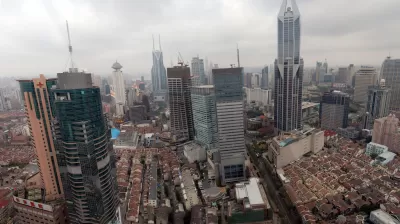After a period of modernization and urban growth unrivaled in human history, several forces promise a slump, or at least a slowing. Maybe it's time to improve existing cities, not keep building new ones.

Whatever your opinion of China's government, it cannot be denied that the country has undergone a miraculous transformation over the past several decades. Pumped up by global and regional trade, the country's cities have absorbed rural migrants in the hundreds of millions.
As Adam Minter writes, "For a while, seemingly all a local government had to do to inspire growth was kick some farmers off their land, build an industrial park and offer tax breaks to the first factory willing to open up." But that might not last too much longer, for several reasons.
The first is demographic. "In the 1970s, China had a surplus of young, under-employed workers in its countryside. That's no longer the case. The working-age population has been in decline since 2011, and the country's birthrate continues to drop."
In addition, the impetus to move to cities has faded somewhat. "Today's workers also aren't nearly as interested in moving away from home as past generations were. Last year, China's migrant population fell by 5.68 million -- the first decline in three decades. Conditions in the countryside have improved markedly in recent years, and rural incomes are rising faster than urban ones, thanks to decades of infrastructure investment and the growing reach of e-commerce."
All things considered, it's unlikely Beijing will meet its goal of boosting the urbanization rate to 60 percent by 2020. But then again, it's China.
FULL STORY: Has China Reached Peak Urbanization?

Planetizen Federal Action Tracker
A weekly monitor of how Trump’s orders and actions are impacting planners and planning in America.

San Francisco's School District Spent $105M To Build Affordable Housing for Teachers — And That's Just the Beginning
SFUSD joins a growing list of school districts using their land holdings to address housing affordability challenges faced by their own employees.

The Tiny, Adorable $7,000 Car Turning Japan Onto EVs
The single seat Mibot charges from a regular plug as quickly as an iPad, and is about half the price of an average EV.

Seattle's Plan for Adopting Driverless Cars
Equity, safety, accessibility and affordability are front of mind as the city prepares for robotaxis and other autonomous vehicles.

As Trump Phases Out FEMA, Is It Time to Flee the Floodplains?
With less federal funding available for disaster relief efforts, the need to relocate at-risk communities is more urgent than ever.

With Protected Lanes, 460% More People Commute by Bike
For those needing more ammo, more data proving what we already knew is here.
Urban Design for Planners 1: Software Tools
This six-course series explores essential urban design concepts using open source software and equips planners with the tools they need to participate fully in the urban design process.
Planning for Universal Design
Learn the tools for implementing Universal Design in planning regulations.
Smith Gee Studio
City of Charlotte
City of Camden Redevelopment Agency
City of Astoria
Transportation Research & Education Center (TREC) at Portland State University
US High Speed Rail Association
City of Camden Redevelopment Agency
Municipality of Princeton (NJ)





























